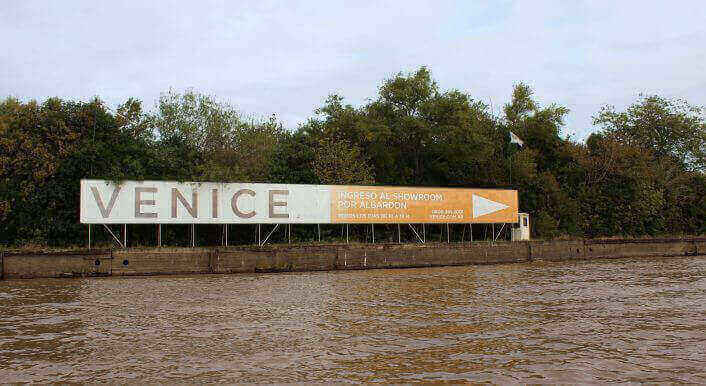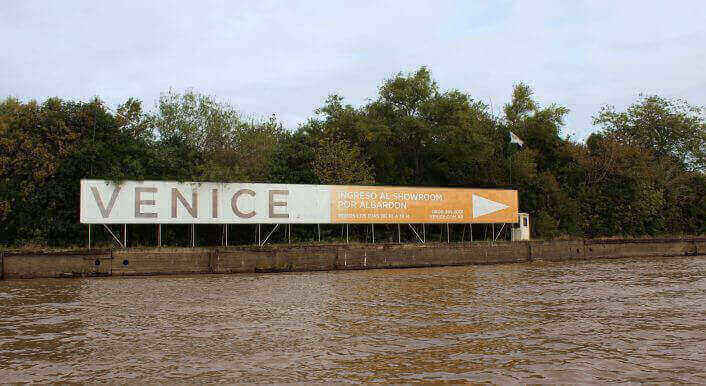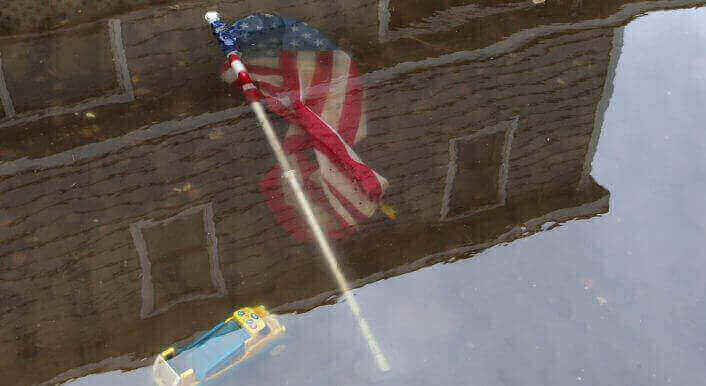French seaside resort heading under the waves
Palavas-les-Flots is a popular seaside resort in southern France, one of several built in the 1960s as part of a government programme to develop tourism along the western Mediterranean seaboard. But the town, like others in the region, now faces disaster from the slow but sure rising sea levels and the coastal erosion exacerbated by mass tourism.
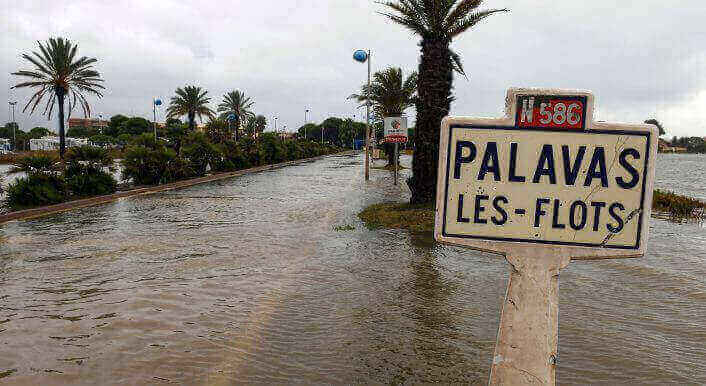
On a roundabout on the avenue lining the Mediterranean seafront at Palavas-les-Flots, a seaside holiday resort close to the town of Montpellier in southern France, a notice board sets out the local municipality’s rules for „better living together“.
These include the wearing of „correct“ clothing in town, and notably shoes, the exhortation to not ride mopeds or motorbikes on the pavement, and to not indulge in loud behaviour – because „noise is a form of pollution and aggression“. But it makes no recommendation that holidaymakers leave their cars behind in favour of walking or using public transport, nor does it urge property developers to stop building on the remaining plots of land between the apartment buildings standing just a few metres from the seafront.
This major resort of the Languedoc region lies on a narrow sandy strip of land about 30 kilometres long that stands as a barrier between small lagoons to the north and the open Mediterranean Sea on its south side. Once a small fishing port, the permanent population of just more than 6,000 is bloated by tens of thousands of tourists during the summer months, largely accommodated in sprawling modern apartment buildings that overlook the beaches and a marina with more than 1,000 berths.
Nowhere along the avenue Saint-Maurice, which is one of the principal residential arteries of Palavas-les-Flots, is there any attempt to draw public attention to coastal erosion, nor to the issue of climate change. But already, in 1982, during an exceptional storm, the sea swept inland for a distance of about 50 metres from the beach. Now, finding passers-by to talk about the threat of flooding appeared to be a vain hope. It might be off-season, but the only pedestrian to be met along the avenue, alive with vehicles and motorbikes, was a Yorkshire Terrier, scurrying along with its head bowed.
But out on the jetty was a woman who said she remembered that last winter the seawater reached the roundabout on the main avenue. She pointed at the low walls made of wood that surround the entrances to the houses along the sandy seafront, still showing the stains of water.
In 2012, the French public agency for the management of surface and sub-surface resources and risks, the BRGM (or „French geological survey“, in English), carried out a study of the vulnerability to sea flooding of the coastline around Palavas-les-Flots. In their modelling projection of the effects on the town of rising sea levels, they notably took into account the events of 1982. They found that if greenhouse gas emissions continue at the current rate and, as a result, that global warming increases above a further 2°Celsius, the consequences for Palavas-les-Flots by 2100 will be considerable. These include saltwater pollution of coastal aquifers, land loss, the disappearance of the beaches (and the entire commercial activity dependent upon them), and a modification of the lagoons that lie behind the town.
“Palavas-les-Flots lies on a low-lying sandy base which has already encountered problems from coastal erosion, like a large part of the Languedoc region’s coast“, said Gonéri Le Cozannet, a BRGM engineer specialised in coastal erosion risks. „The vulnerability of these beaches to marine submersion is already high during storm conditions. Climate change will aggravate this.“
The rise in the sea level at Palavas-les-Flots currently averages three millimetres per year, a rate that is impossible to recognise with the naked eye. But it compares with an estimated average annual rise over the previous 6,000 years of one millimetre per year. This relative surge in sea levels accentuates the risk of erosion caused by heavy swells, notably during storms. The risk has become a major problem because of the recent artificial development of the natural coastline, and also the depletion of the amount of sediment that spills into the Mediterranean from the south-running Rhône river as a consequence of the construction of dams along its course.
“When one looks at the retreat of the Atlantic or Mediterranean coastlines, they suffer from the effects of erosion and storms“, said Éric Chaumillon, a researcher in coastal marine geology at the University of La Rochelle in south-west France. „The contribution made by the rise in the sea level is today very little with regard to the sedimentary dynamics. But in the long-term the effect is real. It is simply a question of timescale.“
The more global temperatures climb, the more the glaciers will melt into the oceans.Meanwhile, the more that beaches suffer from erosion, the lower they lie, and the more the sea rises the more the beaches erode. In Palavas-les-Flots, if the sea rises by 30 centimetres during a storm, the inland flooding will be significantly more extensive, while if the sea rises by a metre the whole of the town centre would be under water.
According to estimations produced by the Intergovernmental Panel on Climate Change, the scientific body that works under the auspices of the United Nations, sea levels will rise by 60 centimetres between now and the year 2100 if global warming increases during that period by an extra 2°C.
In Palavas-les-Flots and the neighbouring coastline, a scientific programme involving dozens of engineers, researchers and administrative officials with the local authorities of the Hérault département (county) is underway to monitor and counter the very real effects of coastal erosion: cameras have been set up to track the erosion of beaches, which is regularly measured, studies have been launched into the effects of storms, prospecting for new sand reserves is underway, along with modelling of the effects locally of climate change. While Palavas-les-Flots is not the most threatened site, it is strategically important because of its location within the surrounding lagoon- and lake-dotted Aigues-Mortes gulf which has a fragile eco-system.
But the scientific programme concerns the whole of the beaches lining the small towns in the same zone. „It is extremely important“, said Alexandre Richard, appointed by the Hérault local authorities to coordinate the coastal study. „The scale of the management of the natural environment dominates that of administrative management.“
A mayor with his head in the sand
In 2008, the most eroded beaches of Palavas-les-Flots and those of nearby Carnon, about five kilometres further east along the strip and a favourite spot for day-trippers from Montpellier, about a 20-minute drive away, were recharged with a total of one million cubic metres of sand. The supplies were taken from the broad width of sands at the pointe de l’Espiguette, at the east-most point of the Aigues-Mortes gulf, where sediment continues to accumulate. The three-month operation cost 8 million euros, but the problems have since returned.
It took just seven years for the popular Petit-Travers beach in Carnon to find itself back to the same depleted level of sand from before the recharge. In Pavalas-les-Flots, about half of the new sand has already disappeared. „The recharge is the only solution that allows for gaining time to raise awareness among [local] populations about long-term strategies“, said Alexandre Richard. „But it’s no miracle solution, because sand reserves are not unlimited and it costs a lot.“
Richard is among those who advocate a soft approach to restoring the beaches and dunes, which includes methods like erecting units of wooden fence protection against wind erosion, beach drainage, and armouring the sands with geotextile defences. Such procedures, and notably recharging eroded sites with new sand, were employed in a lengthy operation to restore the Sète lido, a regularly-eroded stretch of sandy coastline several kilometres long between the towns of Sête and Marseillan, west of Pavalas-les-Flots. The cost of the programme was 54 million euros.
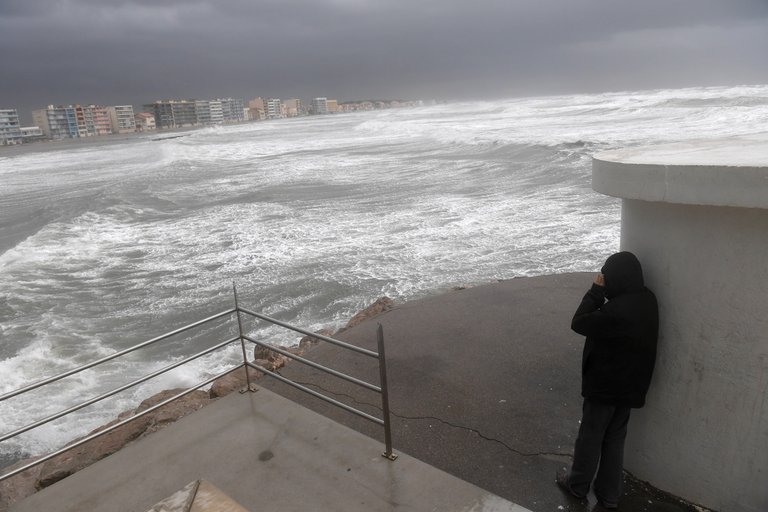
Pascal Guyot / AFP
Faced with its own problems of rising sea levels and coastal erosion, the Netherlands has access to significant undersea sand reserves in the North Sea and the Channel, above an ancient continental plateau. But the Mediterranean Sea, which during the glacial period 21,000 years ago was 120 metres lower than today, is marked by very deep areas of seabed. Meanwhile, if global warming increases by 6°C, the Mediterranean could eventually rise by about another 100 metres or more.
Like many coastal areas, Palavas-les-Flots must adapt to a rise in sea levels that cannot now be avoided. The problems facing the resort are not down to climate change alone, but arise in part from the construction of coastal resorts on the dune banks of the Gulf of Lion. „In this region, most of the coastline is especially vulnerable to climate change“, said Yann Balouin, a geologist and oceanographer with the BRGM. „One of the reasons for this situation is that the lines of dune were destroyed with the building of houses and roads beginning in the 1960s.“
Before the development of the coastal region, there were mostly only small fishing villages along the coast between Sète and Marseille to the east. But in 1963 the so-called „Mission Racine“ was launched, named after Pierre Racine, the senior French civil servant in charge of the government programme to develop the western French Mediterranean coastline, centred on that of the Languedoc-Rousillon region, with the building of tourist resorts and transport infrastructures where once were sands and swamps. Press reports at the time hailed the emergence of a „new Florida“, and the seaside resorts which sprung up are today among the best-known and most popular in France, including La Grande-Motte, Cap d’Agde, Port-Leucate and Port-Barcarès.
Before the construction programme began, Palavas-les-Flots was already a popular spot, but at a far more modest scale than today. For under the Mission Racine, the town’s seafront became lined with large modern buildings within just a few years. The name Palavas-les-Flots became synonymous with summertime seaside tourism, albeit much less chic than the French Riviera, with its facilities adapted to group tourism and children’s holiday camps.
Michel Houellebecq sings “Plein été”, his wry take on Palavas-les-Flots in summertime, when tens of thousands of tourists gather there every year.
French novelist Michel Houellebecq penned a song dedicated to the town in 2000, entitled Plein été(height of summer). The lines, translated here from the original French, went:
“Everything oozes flatness, whiteness, finiteness/An Algerian sweeps the floor of ‘The Dallas’/ Opens the sliding glass windows, his look is pensive/On the beach are a few condoms/A new day comes up over Palavas.“
Today, tourism is by far the major source of revenue for the town, which is developing a new additional line of business in hosting conferences for professional groups at its Phare de la Méditerranée, a 43-metre-tall observation tower (a converted water tower in service until 1997), complete with apartments, conference rooms, and a panoramic restaurant. The kitchens of the restaurant are run by a former winner of the French version of MasterChef, while one of the shareholders is former French footballer Vincent Candela.
After the mushrooming of resorts under the Mission Racine, the environmental consequences emerged, prompting misguided efforts to protect the beaches. These included artificial wave-breakers, and also the laying of lines of barriers made up of rocks which stretch into the sea, perpendicular to the beach, like dark fingers. But while such measures provided some local defences against the sea, they blocked the migration of sediment, aggravating the problems of erosion along the Gulf of Lion coastline.
Christian Jeanjean, the mayor of Pavalas-les-Flots since 1989, member of the conservative Les Républicains party and a former local Member of Parliament for the wider region, denies any existence of a threat from rising sea levels. „We’ve always had a bit of water when there have been storms“, he said, speaking to Mediapart in his vast office at the town hall. „The rise of water levels has been around for 70 years. I can’t say that it’s particularly evident.“ Holding up large-sized colour photos, he argued that the local beaches are in fact growing with sand to the point that it is now invading the town. „We don’t know where to put it anymore“, he said, adding that he would like to see a photo that demonstrates the reality of coastal erosion, jokingly comparing himself to being „like Thomas the Apostle“.
Asked whether he had read the scientific report on the projections of the possible submersion of the town due to the effects of climate change, Jeanjean replied, „I haven’t heard of it“. Did he agree that climate change will necessarily cause a rise in sea levels? „There have been periods of warming and cooling over the last thousands of years“, he answered. „I am a little sceptical if I’m told that over 50 years there’s a change in climate.“ Asked whether he contested the existence of climate change, he said: „No, but before the happening of what you talk about, there will be catastrophes everywhere.“
“We’re going to keep Pavalas natural, and without changes of a nature to hinder nature“, continued Jeanjean. „I am conscious of the problem of climate change, but concerning the rise of water levels Palavas is not for the moment affected.“ At the end of the interview, the mayor offered gifts of a bottle of ‘Pavalos-les-Flots’ perfume, a key ring, and stickers in the form of a fish, capping a somewhat surreal exchange.
While mayor Jeanjean appeared happy to adopt the proverbial position of sticking his head in the sand, a study published in the review Nature Climate Change in February 2016 and co-signed by 22 scientific researchers involved in climate change studies from seven different countries gave a stark warning, underlined by modelling graphics, of the urgency for political initiatives for the vast long-term future of the planet. „Here, we argue that the 20th and 21st centuries, a period during which the overwhelming majority of human-caused carbon emissions are likely to occur, need to be placed into a long-term context, including the past 20 millennia, when the last Ice Age ended and human civilization developed, and the next 10 millennia, over which time the projected impacts of anthropogenic climate change will grow and persist“, they wrote in their introduction to the study, entitled Consequences of 21st-century policy for multi-millennial climate and sea-level change. „This long-term perspective illustrates that policy decisions made in the next few years to decades will have profound impacts on global climate, ecosystems, and human societies – not just for this century, but for the next ten millennia and beyond.“
That implies taking action now to counter problems that are not yet apparent, which is a disturbing prospect but also an exciting one – no less so than developing mass tourist resorts on strips of sand and swamps.

